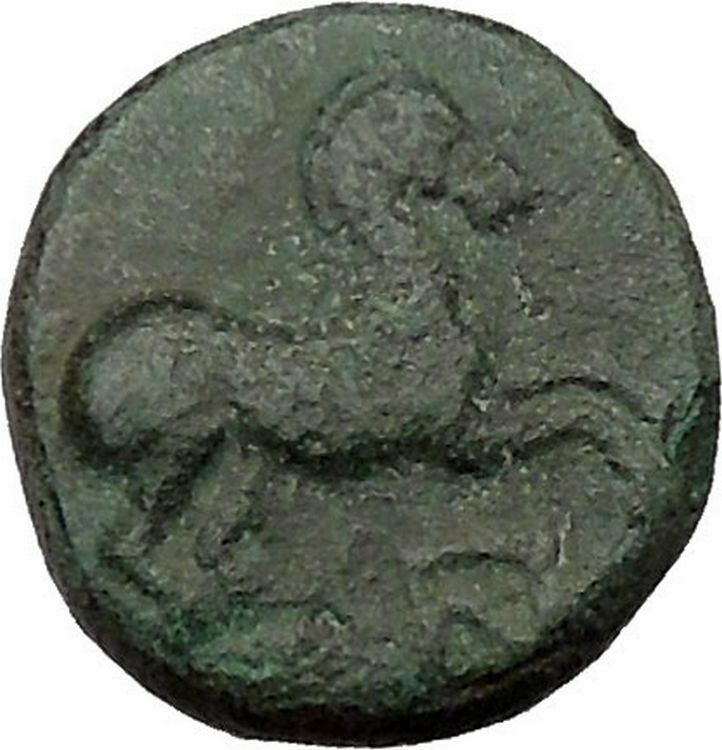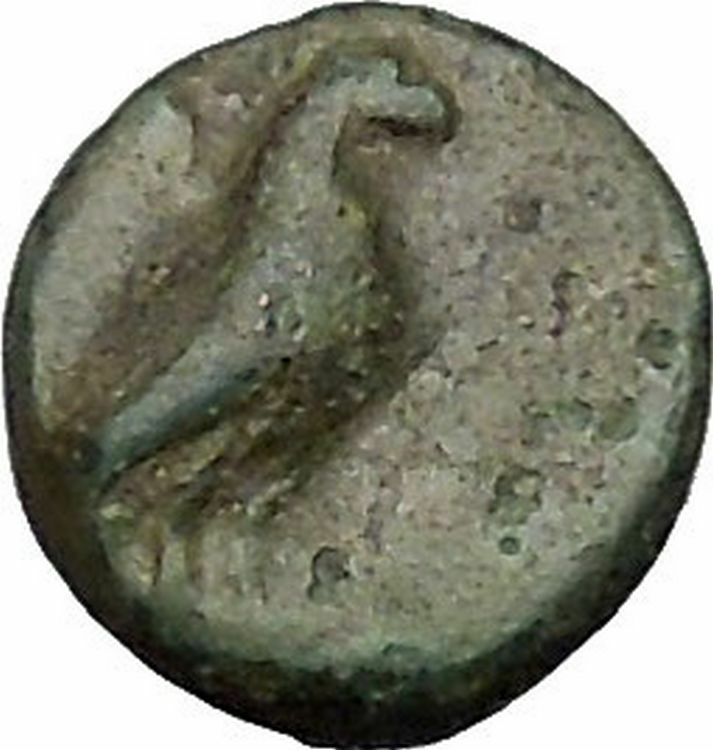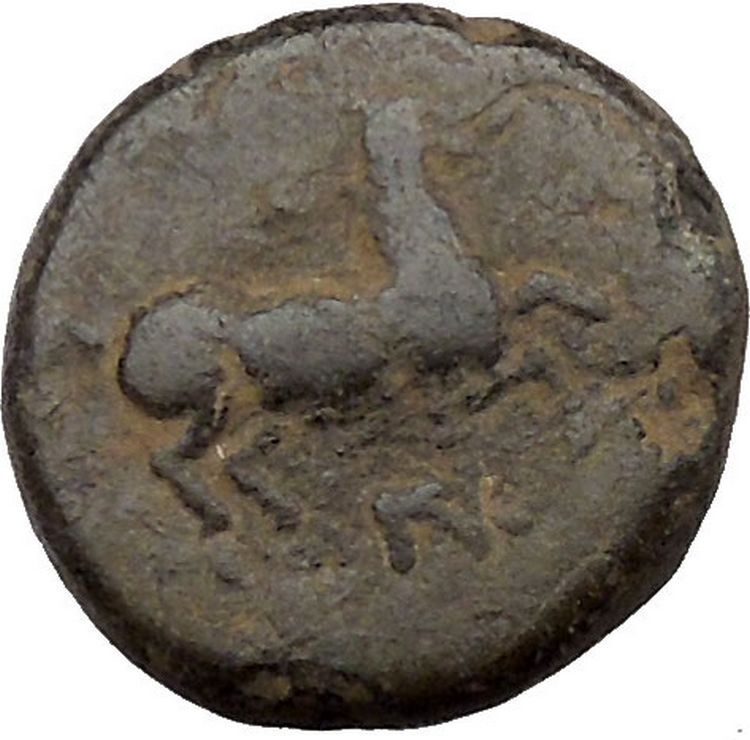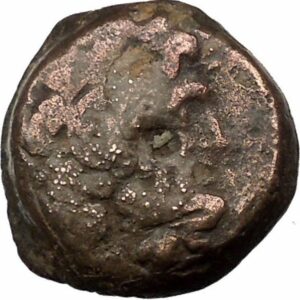Bronze 21mm (7.73 grams) Struck 1st Century B.C. under the Romans
Reference: HGC 2, 1476 (R1);
CNS II, no. 231
Head of Persephone right, wreathed with grain.
ΣΥΡΑΚΟΣΙΩΝ, Demeter standing left, holding torch
and scepter.
When in it’s foundations that the
city of Syracuse only consisted of the island of Ortygia, that island was said
to have been the home of the nymph Arethusa. She had been a chaste, faithful
attendant of Artemis. It is said that she got the unwanted attentions from the
river god, Alpheios, while bathing in his Peloponnesian stream. Artemis hid her
in a cloud in an attempt to save her, however she sweated so profusely out of
fear that she was transformed into a stream. Artemis broke apart the ground to
allow her to escape. She found her way to the island of Ortygia where she became
the fountain on that island.
You are bidding on the exact
item pictured, provided with a Certificate of Authenticity and Lifetime
Guarantee of Authenticity.
In
Greek mythology
,
Persephone is the
daughter of Zeus
and the harvest-goddess
Demeter
, and queen of the
underworld
; she was abducted by
Hades
, the god-king of the underworld.
The myth of her abduction represents her function as the
personification
of
vegetation
which shoots forth in
spring
and withdraws into the earth after
harvest; hence she is also associated with spring and with the seeds of the
fruits of the fields. Persephone as a
vegetation goddess
(Kore) and her mother
Demeter
were the central figures of the
Eleusinian mysteries
that predated the
Olympian pantheon
. In the
Linear B
(Mycenean
Greek
) tablets dated 1400-1200 BC found at
Pylos
, the “two mistresses and the king” are
mentioned;
John Chadwick
identifies these as
Demeter
, Persephone and
Poseidon
.
In
Classical Greek art
, Persephone is invariably
portrayed robed; often carrying a
sheaf
of grain. In
Roman mythology
, she is called
Proserpina

In
Greek mythology
,
Demeter was the goddess
of the harvest, who presided over
grains
, the
fertility
of the earth, the
seasons
(personified by the
Hours
), and the
harvest
. One of her surnames is Sito (σίτος:
wheat) as the giver of food or corn. Though Demeter is often described simply as
the goddess of the harvest, she presided also over the sanctity of
marriage
, the
sacred law
, and the cycle of
life and death
. She and her daughter
Persephone
were the central figures of the
Eleusinian Mysteries
that also predated the
Olympian pantheon.
Her
Roman
cognate is
Ceres
,
pronounced SyracuseeeSicilian
: Sarausa, is a historic
city in
southern Italy
, the
capital
of the
province of Syracuse
. The city is famous for its rich Greek history,
culture
,
amphitheatres
,
architecture
and association to
Archimedes
,
playing an important role in ancient times as one of the top powers of the
Mediterranean
world; it is over 2,700 years old. Syracuse is located in the
south-east corner of the island of
Sicily
, right
by the Gulf of Syracuse next to the
Ionian Sea
.
The city was founded by
Ancient Greek
Corinthians
and became a very powerful
city-state
.
Syracuse was allied with
Sparta
and
Corinth
,
exerting influence over the entire
Magna Grecia
area of which it was the most important city. Once
described by Cicero
as “the greatest Greek city and the most beautiful of them all”, it later became
part of the
Roman Republic
and
Byzantine Empire
. After this
Palermo
overtook it in importance, as the capital of the
Kingdom of Sicily
. Eventually the kingdom would be united with the
Kingdom of Naples
to form the
Two Sicilies
until the
Italian unification
of 1860.
In the modern day, the city is listed by
UNESCO
as a
World Heritage Site
along with the
Necropolis of Pantalica
. In the central area, the city itself has a
population of around 125,000 people. The inhabitants are known as Siracusans,
and the local language spoken by its inhabitants is the
Sicilian language
. Syracuse is mentioned in the
Bible
in the
Acts of the Apostles
book at 28:12 as
Paul
stayed there.[2]
The patron saint
of the city is
Saint Lucy
;
she was born in Syracuse and her feast day,
Saint Lucy’s Day
, is celebrated on 13 December.
Greek period
Syracuse and its surrounding area have been inhabited since ancient times, as
shown by the findings in the villages of Stentinello, Ognina, Plemmirio,
Matrensa, Cozzo Pantano and Thapsos, which already had a relationship
with
Mycenaean Greece
.
Syracuse was founded in 734 or 733 BC by Greek settlers from
Corinth
and Tenea
,
led by the oecist (colonizer)
Archias
, who called it Sirako, referring to a nearby salt marsh. The
nucleus of the ancient city was the small island of Ortygia. The settlers
found the land fertile and the native tribes to be reasonably well-disposed to
their presence. The city grew and prospered, and for some time stood as the most
powerful Greek city anywhere in the
Mediterranean
. Colonies were founded at
Akrai
(664 BC),
Kasmenai
(643 BC),
Akrillai
(VII century BC), Helorus
(VII century BC) and
Kamarina
(598 BC). The descendants of the first colonist, called Gamoroi, held the
power until they were expelled by the Killichiroi, the lower class of the
city. The former, however, returned to power in 485 BC, thanks to the help of
Gelo, ruler of
Gela. Gelo himself
became the despot of the city, and moved many inhabitants of Gela, Kamarina and
Megera to Syracuse, building the new quarters of
Tyche
and
Neapolis
outside the walls. His program of new constructions included a new
theater, designed by
Damocopos
, which gave the city a flourishing cultural life: this in turn
attracted personalities as
Aeschylus
,
Ario of
Metimma
, Eumelos of
Corinth
and
Sappho
, who had
been exiled here from
Mytilene
.
The enlarged power of Syracuse made unavoidable the clash against the
Carthaginians
, who ruled western Sicily. In the
Battle of Himera
, Gelo, who had allied with Theron of
Agrigento
,
decisively defeated the African force led by
Hamilcar
. A
temple
,
entitled to Athena
(on the site of the today’s Cathedral), was erected in the city to commemorate
the event
Gelon was succedeed by his brother
Hiero
, who
fought
against the
Etruscans
at Cumae
in 474 BC. His rule was eulogized by poets like
Simonides of Ceos
,
Bacchylides
and Pindar
, who visited his court. A democratic regime was introduced by
Thrasybulos
(467 BC). The city continued to expand in
Sicily
,
fighting against the rebellious
Siculi
, and on the
Tyrrhenian Sea
, making expeditions up to
Corsica
and
Elba. In the late
5th century BC, Syracuse found itself at war with
Athens
, which
sought more resources to fight the
Peloponnesian War
. The Syracusans enlisted the aid of a general from
Sparta
, Athens’
foe in the war, to defeat the Athenians, destroy their ships, and leave them to
starve on the island (see
Sicilian Expedition
). In 401 BC, Syracuse contributed a force of 3,000
hoplites
and a general to
Cyrus the Younger
‘s
Army of the Ten Thousand
.
Then in the early 4th century BC, the
tyrant
Dionysius the Elder
was again at war against
Carthage
and, although losing Gela and Camarina, kept that power from capturing the whole
of Sicily. After the end of the conflict Dionysius built a massive fortress on
the Ortygia
island of the city and 22 km-long walls around all of Syracuse. Another period
of expansion saw the destruction of
Naxos
, Catania
and Lentini
, then Syracuse entered again in war against Carthage (397 BC). After
various changes of fortune, the Carthaginians managed to besiege Syracuse
itself, but were eventually pushed back by a pestilence. A treaty in 392 BC
allowed Syracuse to enlarge further its possessions, founding the cities of
Adrano, Ancona
,
Adria
, Tindari
and Tauromenos, and conquering
Reggio Calabria
on the continent. Apart from his battle deeds, Dionysius was
famous as a patron of art, and
Plato
himself
visited Syracuse several times.
His successor was
Dionysius the Younger
, who was however expelled by
Dion
in 356 BC. But the latter’s despotic rule led in turn to his expulsion,
and Dionysius reclaimed his throne in 347 BC. A democratic government was
installed by Timoleon
in 345 BC. The long series of internal struggles had weakened
Syracuse’s power on the island, and Timoleon tried to remedy this, defeating the
Carthaginians in 339 BC near the
Krimisos
river. But the struggle among the city’s parties restarted after
his death and ended with the rise of another tyrant,
Agathocles
,
who seized power with a coup in 317 BC. He resumed the war against Carthage,
with alternate fortunes. He however scored a moral success, bringing the war to
the Carthaginians’ native African soil, inflicting heavy losses to the enemy.
The war ended with another treaty of peace which did not prevent the
Carthaginians interfering in the politics of Syracuse after the death of
Agathocles (289 BC). The citizens called
Pyrrhus of Epirus
for help. After a brief period under the rule of Epirus,
Hiero II
seized power in 275 BC.
Hiero inaugurated a period of 50 years of peace and prosperity, in which
Syracause became one of the most renowned capitals of Antiquity. He issued the
so-called Lex Hieronica, which was later adopted by the Romans for their
administration of Sicily; he also had the theater enlarged and a new immense
altar
, the “Hiero’s
Ara”, built. Under his rule lived the most famous Syracusan, the
natural philosopher
Archimedes
.
Among his many inventions were various military engines including the
claw of Archimedes
, later used to resist the
Roman
siege of 214 BC–212 BC. Literary figures included
Theocritus
and others.
Hiero’s successor, the young
Hieronymus
(ruled from 215 BC), broke the alliance with the Romans after
their defeat at the
Battle of Cannae
and accepted
Carthage
‘s
support. The Romans, led by consul
Marcus Claudius Marcellus
,
besieged the city
in 214 BC. The city held out for three years, but fell in
212 BC. It is believed to have fallen due to a peace party opening a small door
in the wall to negotiate a peace, but the Romans charged through the door and
took the city, killing Archimedes in the process.
From
Roman domination to the Middle Ages
Though declining slowly by the years, Syracuse maintained the status of
capital of the Roman government of Sicily and seat of the
praetor
. It
remained an important port for the trades between the Eastern and the Western
parts of the Empire.
Christianity
spread in the city through the efforts of
Paul of Tarsus
and Saint Marziano, the first bishop of the city, who made it
one of the main centres of
proselytism
in the West. In the age of the persecutions massive
catacombs
were carved, whose size is second only to those of Rome.
After a period of
Vandal
rule, Syracuse and the island was recovered by
Belisarius
for the
Byzantine Empire
(31 December 535). From 663 to 668 Syracuse was the seat of
Emperor Constans II
, as well as metropolis of the whole Sicilian Church.
Another siege in 878, resulted in the city coming under two centuries of
Muslim
rule. The
capital was moved from Syracuse to
Palermo
. The
Cathedral was converted into a
mosque
and the
quarter on the Ortygia island was gradually rebuilt along Islamic styles. The
city, nevertheless, maintained important trade relationships, and housed a
relatively flourishing cultural and artistic life: several Arab poets, including
Ibn Hamdis
,
the most important Sicilian poet of the 12th century, flourished in the city.
In 1038, the Byzantine general
George Maniaces
reconquered the city, sending the relics of St. Lucy to
Constantinople
. The eponymous castle on the cape of Ortygia bears his name,
although it was built under the
Hohenstaufen
rule. In 1085 the
Normans
entered Syracuse, one of the last
Arab
strongholds, after a summer-long siege by
Roger I of Sicily
and his son
Jordan of Hauteville
, who was given the city as count. New quarters were
built, and the cathedral was restored, as well as other churches.
In 1194
Henry VI
of Swabia
occupied Syracuse. After a short period of
Genoese
rule (1205–1220), which favoured a rise of trades, Syracuse was
conquered back by emperor
Frederick II
. He began the construction of the
Castello Maniace
, the Bishops’ Palace and the Bellomo Palace. Frederick’s
death brought a period of unrest and feudal anarchy. In the struggle between the
Anjou
and
Aragonese
monarchies, Syracuse sided with the Aragonese and defeated the
Anjou in 1298, receiving from the Spanish sovereigns great privileges in reward.
The pre-eminence of baronal families is also shown by the construction of the
palaces of Abela
,
Chiaramonte
, Nava
,
Montalto
.









